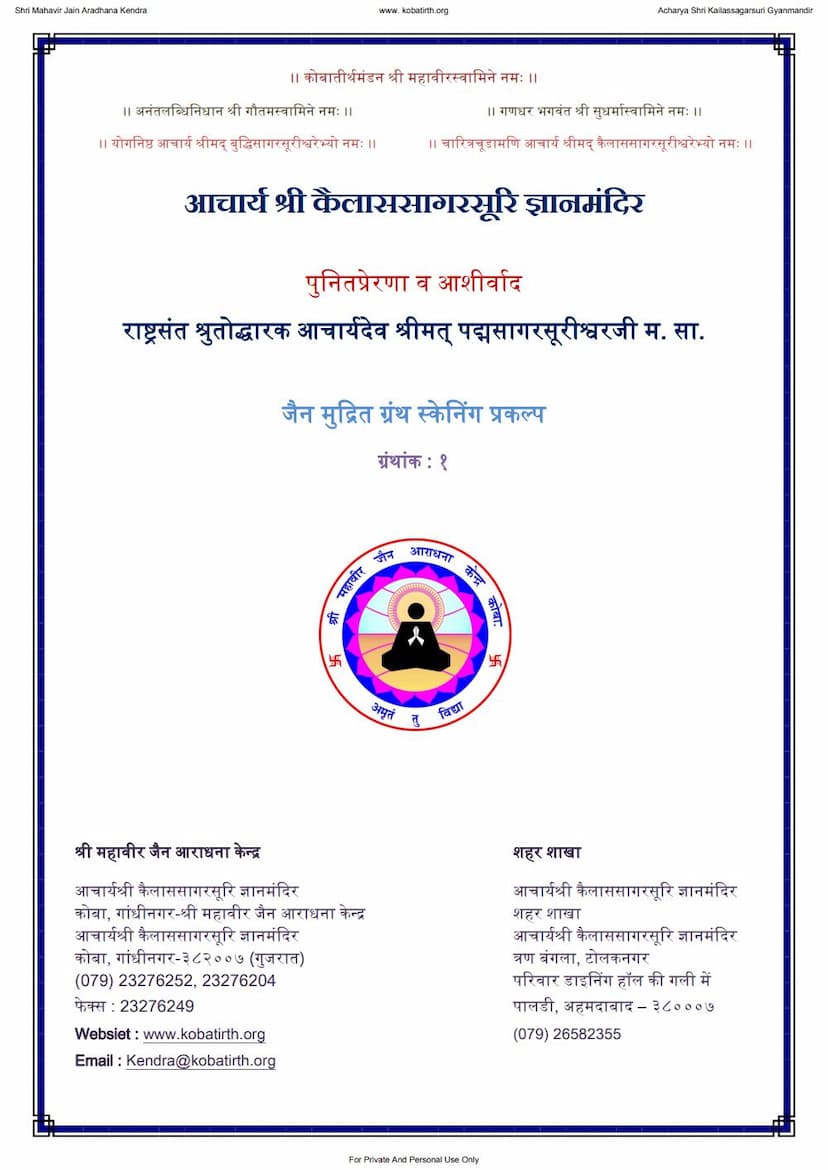Agam 20 Upang 09 Kalpavatansika Sutra Shwetambar
Added to library: September 1, 2025

Summary
This document appears to be a scanned copy of a Jain religious text, specifically the Kalpavatikasutra (कल्पवतिकसूत्र), which is the ninth Upanga (minor scripture) of the Agamas. The title also indicates it's from the Shwetambar tradition. The document is attributed to Purnachandrasagar as the author and published by Jainanand Pustakalay.
Here's a comprehensive summary of the provided pages:
Overall Purpose:
The document is a reproduction of a Jain Agam text, the Kalpavatikasutra, within the Shwetambar tradition. It highlights the importance of these scriptures, their historical transmission, and the lineage of scholars who have preserved and disseminated them. The initial pages are largely dedications, acknowledgments, and a historical overview of the Agamas and their recensions (Vachanas). The latter part contains the actual text of the Kalpavatikasutra, presented in its original Prakrit with Gujarati script.
Key Themes and Content:
- Spiritual Devotion and Homage: The first pages are filled with salutations to revered Jain acharyas (spiritual leaders) and deities, such as Gautam Swami, Mahavir Swami, and the lineage of gurus. This reflects the devotional nature of Jainism.
- The Jain Agamas and their Importance: The text emphasizes the paramount importance of the Agamas as the divine word (Vani) of Lord Mahavir. It stresses that these scriptures are the source of true knowledge, guiding beings out of ignorance and the cycle of rebirth.
- Historical Overview of the Agamas and their Recensions (Vachanas): A significant portion (pages 6-10) is dedicated to a detailed historical account of the Agamas and the six major recensions (Vachanas) that took place after Lord Mahavir's demise. This section explains:
- The purpose of these recensions: To preserve and protect the Agamic knowledge from being lost due to various challenges like famines, political turmoil, and the decline in the capacity of ascetics to memorize them.
- The circumstances of each Vachana: Each recension is described with its approximate timeframe, the location (e.g., Pataliputra, Ujjain, Kalinga, Dashpur, Mathura, Valabhi), the presiding Acharyas, and the number of participants.
- The evolution of the Agamas: The recensions highlight efforts to compile, organize, and codify the vast body of Jain knowledge, including the twelve Angas and fourteen Purvas.
- The role of scholars: The text acknowledges the contributions of various learned ascetics who played crucial roles in these recensions.
- The Role of Purnachandrasagar and Jainanand Pustakalay: The publication is presented as a result of dedicated efforts by various individuals and institutions.
- Purnachandrasagar: Appears to be the scholar responsible for the collation and editing of this specific edition.
- Jainanand Pustakalay, Surat: The publishing house that has brought out this work.
- Acharya Shri Kailassagarsuri Gyanmandir: This institution seems to be involved in the scanning and digitization project.
- The Specific Text: Kalpavatikasutra (कल्पवतिकसूत्र): Pages 12-15 onwards begin to present the actual text of the Kalpavatikasutra.
- Structure of the Kalpavatikasutra: It's mentioned that the Kalpavatikasutra is the ninth Upanga and comprises ten chapters (Adhyayanas).
- Content of the first chapters: The excerpt begins with details about the first two chapters, "Padme" (पउमे) and "Mahapadme" (महापउमे). It describes the lineage of characters and events, including the birth and renunciation of Prince Padma and Mahapadma, their spiritual journeys, and their eventual rebirths in the heavens and subsequent lives in Mahavideha. These narratives seem to illustrate Jain principles, karma, and the path to liberation.
- Genealogical Structure: The text mentions the mother's name often corresponds to the son's name, and it outlines the sequence of rebirths and ascensions within different heavens (Swaraga).
- Preservation Efforts: The text highlights the continuous efforts to preserve Jain knowledge, especially the Agamas, through various challenges over centuries. It speaks of the dedication of scholars who undertook the monumental task of researching, editing, and printing these ancient texts. The mention of "seven collective readings" and the printing of 2,33,200 verses underscores the scale of these preservation efforts.
- Modern Revival and Scholarship: The document implicitly praises the modern scholars and institutions that are involved in reviving and making these ancient texts accessible to the public through printing and digitization. The preface mentions the continuous lineage of scholars, emphasizing the unbroken chain of knowledge transmission.
In essence, this document is a testament to:
- The divine authority and importance of the Jain Agamas.
- The historical efforts to preserve and transmit this knowledge through various recensions and scholarly endeavors.
- The dedication of scholars and institutions like Purnachandrasagar and Jainanand Pustakalay in making these scriptures accessible to the modern world.
- The narrative and ethical teachings contained within the Kalpavatikasutra itself, exemplified by the stories of Prince Padma and Mahapadma.